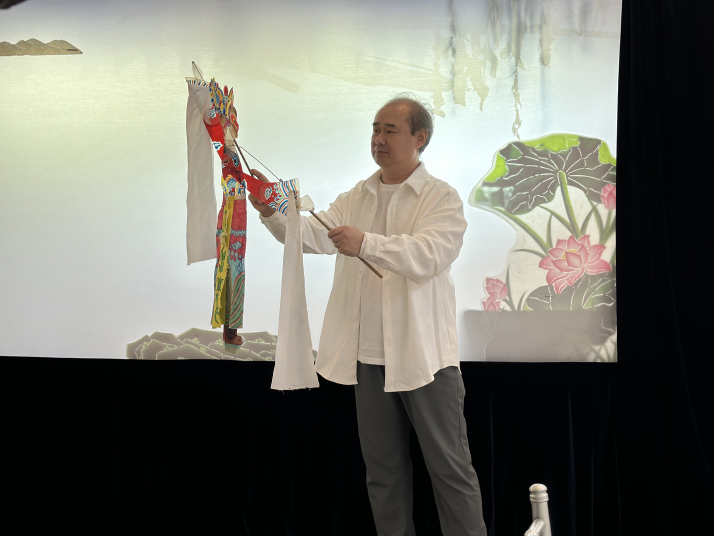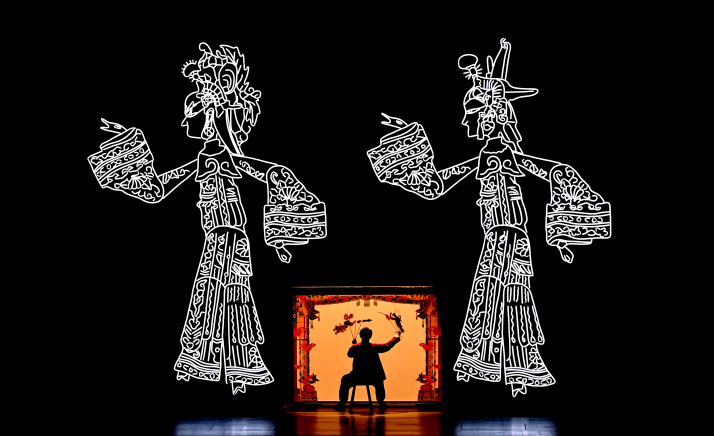| Lifestyle |
| A traditional Chinese puppetry performance—with a contemporary twist | |
|
|
 Lu Baogang introduces a Chinese shadow puppet (COURTESY PHOTO)
Accompanied by music, a humorous story unfolds as a turtle and a crane engage in playful antics, brought to life through the clever interplay of light and curtain in a Chinese shadow puppetry performance. The audience appears very much entertained, with bursts of laughter echoing throughout the shenanigans unfolding on stage. Backstage, Lu Baogang, a national-level inheritor of Beijing shadow puppetry art, and the other performers of the Beijing Shadow Show Troupe, expertly manipulate the silhouettes. The crane executes a series of complex movements that are particularly difficult to manage for the puppeteers. Having assumed the mantle from his father at the age of 15, Lu once spent hours at the zoo observing the cranes' every move. Now aged 60, Lu, also the troupe's director, has over four decades of experience in the art of shadow puppetry. Chinese shadow puppetry, a fusion of light, shadow, drawing and singing, traces its origins to the Western Han Dynasty (206 B.C.-A.D. 8). It evolved and peaked through the subsequent dynasties, and even spread as far as Europe and Western Asia during the Yuan Dynasty (1279-1368). Inscribed on UNESCO's Representative List of the Intangible Cultural Heritage of Humanity in 2011, the traditional puppetry art now faces the challenges posed by contemporary entertainment. All across China, Lu and other inheritors of the art form are looking for new ways to revive the age-old tradition by exploring new avenues, attracting attention and appreciation for their relentless quest for renewal. Cross-cultural to cross-sector Over the years, the audience turnout for Chinese shadow puppetry shows has declined. For artists of Lu's generation, the challenge of finding new ways to innovate has become paramount. Lu has long been aware that traditional shadow puppetry does not enjoy great success in the marketplace, being less popular than other art forms. This realization is what prompted his company to explore inter-theater fusion. "This fusion involves combining shadow puppetry with other theatrical genres such as spoken theater, musical comedy and puppet theater. This goal is to address certain limitations of our art, such as its flat, two-dimensional presentation," Lu told ChinAfrica magazine, a China International Communications Group publication that focuses on reporting news and stories related to China-Africa relations. While the specific two-dimensional nature of shadow puppetry is a strength, it can also be a weakness in terms of visual impact. Artists are seeking to remedy this by integrating more visually dynamic theatrical forms on stage, moving beyond the traditional backdrop of a simple curtain, he added. The first such experiment occurred in 2015. At a shadow puppetry competition, Lu won the Creativity Award with his play The Legend of Meng Jiangnu, a famous Chinese folk tale combining human and puppetry performances. This success encouraged him to innovate the art form. Building on this approach, Lu's troupe has produced two highly acclaimed plays: In 2019, The Legend of the Shadows was created, followed by The Shadow Box's Fantastic Journey in 2023. Both productions combine shadow puppetry with a range of techniques and forms of expression, including human shadows, paper silhouettes, and shadow landscapes. They also explore innovative concepts in set design, musical accompaniment and staging. "Our objective with these two plays was, and is, to attract a younger audience," Lu noted while highlighting the positive reception the shows have received. Other shadow puppetry troupes across the country are also embracing innovation. For example, Wang Haiyan, a representative inheritor of shadow play in northwest China's Shaanxi Province, is incorporating elements from cartoons and video games into her contemporary puppet designs. Wang was inspired by a cartoon festival she visited with her son a few years ago, motivating her to create new shadow puppets that merge traditional craftsmanship and modern influences. She has also actively pursued "cross-sector" cooperation with different industries, including clothing, automotive and fashion brands. This approach provides opportunities for the art form to reach new audiences and stay relevant in a swiftly changing cultural landscape.  Shadow puppetry performance fuses Chinese shadow theater with state-of-the-art projection techniques at an art center in Xi'an, Shaanxi Province, on February 11 (XINHUA)
Tech-tastic In today's evolving society, digital technology offers the time-honored art of shadow puppetry both opportunities and resources, opening up new artistic perspectives. Recognizing the growing interest in immersive experiences like 4D films, Liu Chaokan, a representative inheritor of shadow play in southwest China's Yunnan Province, has opted to incorporate 4D elements into the performances. This is quite the feat in the realm of shadow puppetry, as it marks the first instance of traditional shadow play techniques being combined with holographic projection technology on a contemporary stage. One production showcasing this innovation is The Memories of Tengchong, which offers spectators a full-fledged immersive theater experience. "We must not deny our traditions, but enrich them with new elements so that shadow puppetry continues to be appreciated in modern times," said Liu. In the current media landscape, one shadow puppetry troupe in Haining, Zhejiang Province in east China, leverages the power of the Internet extensively for promotion. Liu Fan, a young performer with the troupe, regularly creates and shares short videos online, giving netizens access to behind-the-scenes processes and techniques. His videos are very popular on Chinese social media platforms. A video of the play The Tortoise and the Crane gained 15 million views and 36,000 likes on Douyin, the Chinese version of TikTok. Similarly, the Beijing Shadow Show Troupe, where Lu is active, also acknowledges the importance of raising one's online profile. The troupe has already collaborated with major Chinese Internet and tech platforms such as Bilibili, China's equivalent of YouTube that primarily caters to Gen Z, and NetEase, one of the country's leading gaming players. These partnerships have yielded positive results. For instance, in one collaboration with Bilibili to endorse a video game, they produced a promotional video featuring shadow puppetry, which attracted considerable viewers count. Despite his impending retirement in October, Lu has no intention of giving up his role in maintaining the art form's survival. He said that pursuing innovative developments remains a priority. "The art of shadow puppetry is deeply rooted in our culture and I am committed to perpetuating it. Nothing and no one can stop me, because this is what inheritors must do," he added. BR This article was first published in ChinAfrica magazine (Print Edition Title: Behind the Shadows) Copyedited by Elsbeth van Paridon Comments to yushujun@cicgamericas.com |
|
||||||||||||||||||||||||||||||
|